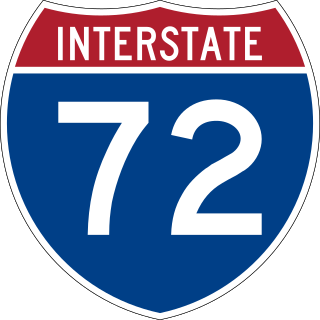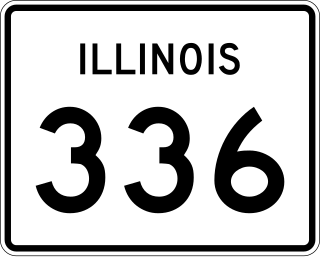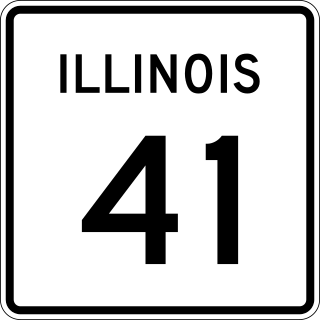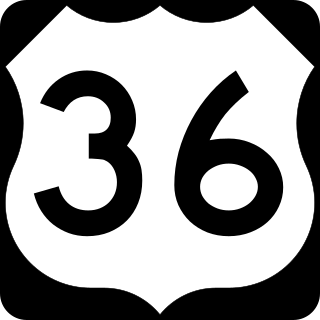Related Research Articles

Interstate 72 (I-72) is an Interstate Highway in the Midwestern United States. Its western terminus is in Hannibal, Missouri, at an intersection with U.S. Route 61 (US 61); its eastern terminus is at Country Fair Drive in Champaign, Illinois. The route runs through the major cities of Decatur, Illinois, and Springfield, Illinois. In 2006, the Illinois General Assembly dedicated all of I-72 as Purple Heart Memorial Highway. The stretch between Springfield and Decatur is also called Penny Severns Memorial Expressway, and the section between mile 35 and the Mississippi River is known as the Free Frank McWorter Historic Highway.

U.S. Route 69 (US 69) is a major north–south United States highway in the central United States. When it was first created, it was only 150 miles (241 km) long, but it has since been expanded into a Minnesota to Texas cross-country route. The highway's southern terminus is in Port Arthur, Texas at an intersection with State Highway 87. Its northern terminus is in Albert Lea, Minnesota at Minnesota State Highway 13.

U.S. Route 24 or U.S. Highway 24 (US 24) is one of the original United States Numbered Highways of 1926 which runs east and west for most of its routing. It originally ran from Pontiac, Michigan, in the east to Kansas City, Missouri, in the west. Today, the highway's eastern terminus is in Independence Township, Michigan, at an intersection with Interstate 75 (I-75), and its western terminus is near Minturn, Colorado, at an intersection with I-70. The highway transitions from north–south to east–west signage at the Ohio–Michigan state line.
The Avenue of the Saints is a 563-mile-long (906 km) highway in the Midwestern United States that connects St. Louis, Missouri, and St. Paul, Minnesota.

U.S. Route 34 (US 34) is an east–west United States highway that runs for 1,122 miles (1,806 km) from north-central Colorado to the western suburbs of Chicago. Through Rocky Mountain National Park it is known as the Trail Ridge Road where it reaches an elevation of 12,183 feet (3,713 m), making it one of the highest paved through highways in the United States. The highway's western terminus is Granby, Colorado at US 40. Its eastern terminus is in Berwyn, Illinois at Illinois Route 43 and Historic US 66.

U.S. Route 136 is an east-west U.S. highway that is a spur route of U.S. Route 36. It runs from Edison, Nebraska, at U.S. Route 6 and U.S. Route 34 to the Interstate 74/Interstate 465 interchange in Speedway, Indiana. This is a distance of 804 miles (1,294 km). Due to the removal of almost every numbered route in Indianapolis, US 136 never meets its parent, US 36; however, it does come within two miles of it at its interchange with I-465/I-74 at its eastern terminus.

The Illinois Zephyr and Carl Sandburg are a pair of passenger trains operated by Amtrak on a 258-mile (415 km) route between Chicago and Quincy, Illinois. As Illinois Service trains, they are partially funded by the Illinois Department of Transportation. Between Chicago and Galesburg, Illinois, the trains share their route with the California Zephyr and Southwest Chief; the remainder of the route (Galesburg–Quincy) is served exclusively by the Illinois Zephyr/Carl Sandburg.

Illinois Route 116 is a 176.07-mile-long (283.36 km) cross-state rural state highway that runs from U.S. Route 34 by Gladstone east to the intersection of US 45 and Old US 45, on the north side of Ashkum.

Interstate 172 (I-172) is a spur route, the only auxiliary route of I-72. It is located entirely within the US state of Illinois and is completely concurrent with IL 110. The highway runs north from its start outside of Hannibal, Missouri, to about 2.5 miles (4.0 km) west of Fowler. At U.S. Route 24 (US 24), I-172 becomes Illinois Route 336 (IL 336), which runs north and east to Macomb via Carthage. The entire portion of I-172 and I-72 from I-172 east to Springfield is also known by its former name, the Central Illinois Expressway. I-172 is 19.69 miles (31.69 km) long.

Illinois Route 336 is a four-lane freeway/expressway combination that serves western Illinois. It is also used by the Illinois Department of Transportation (IDOT) as a part of Federal-Aid Primary Highway 315 (FAP315) to refer to a future project connecting the cities of Quincy and Peoria via underserved Macomb.

Forgottonia, also spelled Forgotonia, is the name given to a 16-county region in Western Illinois in the late 1960s and early 1970s. This geographic region forms the distinctive western bulge of Illinois that is roughly equivalent to "The Tract", the Illinois portion of the Military Tract of 1812, along and west of the Fourth Principal Meridian. Since this wedge-shaped region lies between the Illinois and Mississippi rivers, it has historically been isolated from the eastern portion of Central Illinois.

Illinois Route 41 is a north–south route in rural west-central Illinois. It runs from U.S. Route 136 near Macomb north to U.S. Route 34 and Illinois Route 164 in Galesburg, a distance of 37.53 miles (60.40 km). Illinois 41 is maintained by the Illinois Department of Transportation.

U.S. Route 24 (US 24) in the U.S. state of Illinois is a major arterial road that runs from the Missouri state line at the Mississippi River in Quincy to Sheldon. This is a distance of 255.13 miles (410.59 km).

The Hannibal and St. Joseph Railroad was the first railroad to cross Missouri starting in Hannibal in the northeast and going to St. Joseph, Missouri, in the northwest. It is said to have carried the first letter to the Pony Express on April 3, 1860, from a train pulled behind the locomotive Missouri.
The Central Association was an American minor league baseball league. The Central Assocation began play in 1908, evolving from the 1907 Iowa State League. The Central Association played continuously through 1917 before folding. The league reformed in 1947, operating as a Class C level league from 1947 to 1949, with major league affiliates for most teams.

U.S. Route 36 in the state of Missouri is an expressway with many freeway sections, connecting Kansas to Illinois. From Cameron to the Illinois state line, it forms part of the principal route between Kansas City and Chicago, known as the Chicago–Kansas City Expressway.

The Chicago–Kansas City Expressway is a highway that runs between Chicago, Illinois, and Kansas City, Missouri. The road is known as Route 110 in Missouri and Illinois Route 110 (IL 110) in Illinois. IL 110 was created through legislation on May 27, 2010, as the designated route for the Illinois portion of the Chicago–Kansas City Expressway.

The Wabash Railroad was a Class I railroad that operated in the mid-central United States. It served a large area, including track in the states of Ohio, Indiana, Illinois, Iowa, Michigan, and Missouri and the province of Ontario. Its primary connections included Chicago, Illinois; Kansas City, Missouri; Detroit, Michigan; Buffalo, New York; St. Louis, Missouri; and Toledo, Ohio.
The Mississippi River Scenic Highway was an auto trail in the United States, created in 1919 to connect the US Midwest with the Southern United States. It was expanded to include a branch to Miami.
References
- ↑ Current Events. Kansas City Southern Railway. 1914.
- 1 2 Clarke, Dave (January 8, 2013). "Cannon Ball Trail was early attempt at self-guided travel". Star Courier . Retrieved February 25, 2013.
- 1 2 3 4 "Association Posting Trail". Automobile Journal. 34. 1912.
- ↑ Map of Iowa Showing Principal Automobile Routes (Map). Kenyon Map Company. 1919.
- ↑ Illinois State Highway Department (1917). Map Showing Marked Through Routes in Illinois (Map). Scale not given. Springfield: Illinois State Highway Department. Retrieved November 21, 2020– via Illinois Digital Archives.
- ↑ "To Extend Cannon Ball Trail". Motor Age. 27. 1915.